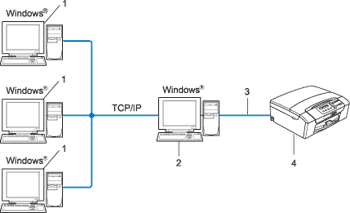



  |   |

| • | In a smaller network of 2 or 3 computers, we recommend the Peer-to-Peer printing method as it is easier to configure than the Network Shared Printing method. (See Network Shared Printing.) |
| • | Each computer must use the TCP/IP Protocol. |
| • | The Brother machine needs an appropriate IP address configuration. |
| • | If you are using a router, the Gateway address must be configured on the computers and the Brother machine. |

| 1. | Client computer |
| 2. | Also known as “Server” or “Print Server” |
| 3. | TCP/IP or USB (where available) |
| 4. | Network printer (your machine) |
  |   |